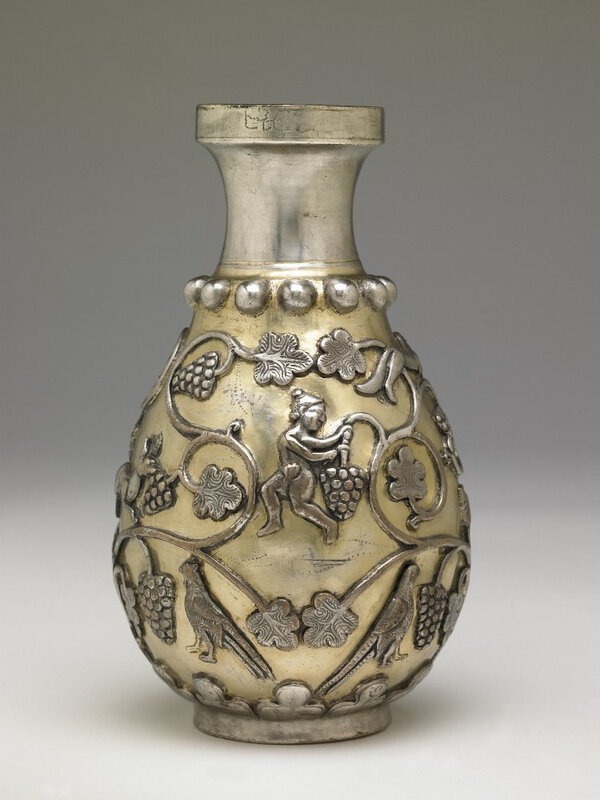The Asahi Shimbun Displays 'Feeding history: the politics of food'
LONDON.- The British Museum’s new Asahi Shimbun display will explore the relationship between food, power and control through a focussed selection of objects. More food is being produced than ever before, but hunger remains one of the biggest threats to society today – in 2017, the United Nations estimated that around one in nine people around the world are undernourished. The Asahi Shimbun Displays Feeding history: the politics of food will place ancient objects alongside a contemporary sculpture to explore the issues surrounding the production and control of food resources throughout human history.
At the centre of this display is a poignant sculpture Anti Social Wild West Weaving, evoking the harsh conditions faced by North Americans in their attempt to harvest traditional foods on their homelands. It depicts the barbed-wire fences that settlers used to claim the North American grasslands for cattle grazing and farming. Yet these fences simultaneously restricted Native Americans from accessing their ancestral land, and scraps of fabric caught between the wires capture the difficult moment of crawling through the wires. Pat Courtney Gold is a member of the Wasco tribe, and her emotive work adapts a distinctive twining technique used to create the Sally Bag, a traditional basket unique to Wasco people and used for collecting food.
Pat Courtney Gold (Native North American; Female; 1939; active), Anti Social Wild West Weaving, circa 2000. Sculpture representing range land fencing; made from twined, two strand antique steel wire incorporating numerous four point barbs. Two scraps of printed calico are attached. © the Trustees of the British Museum.
This sculpture will be juxtaposed with a 1952 American educational film that also functions as cowboy propaganda. The film tells the perspective of new settlers in Midwest America, who proudly announce that by using barbed-wire fences, the prairies have been transformed into ‘open-air factories.’ Together these works draw attention to an age old conflict between nomads, farmers and herders, who use natural resources for food in different ways. It is a conflict that continues today across the world in places like Nigeria, Kenya and Brazil.
This display will also include four ancient objects, tracing the modern issue of hunger back to the beginning of human farming for food. An ancient Egyptian plough dating to 1550 – 1069 BC bears traces of a bronze blade that was used to churn up fertile soil brought about by the river Nile’s annual flood. Predictable and reliable crops fuelled population growth as people began to settle and farm, and villages grew into towns and cities. However, farming also led to the ownership of land as well as the emergence of a hierarchal society.
Wooden plough handle bearing traces of the bronze blade, Egypt, New Kingdom (1550 – 1069 BC). Wood, bronze. © the Trustees of the British Museum.
A butcher shop model found in an ancient Egyptian tomb for the deceased to take with them into the afterlife will also be on display, representing the other main sector of agriculture – raising livestock. Showing two oxen being slaughtered as a meat offering, this object reflects the ways in which animal domestication was closely linked to power structures in historic societies. Breeding and maintaining livestock was an expensive venture, and so the frequent consumption of meat – along with its slaughter for the afterlife - was exclusive to the wealthy elite in ancient Egypt.
Trade and the exchange of food resources and technologies have been crucial in the history of food consumption; it is predicted that over 50% of the world’s population could rely on food imports by 2050. Two vessels both adorned with grapevines will be on display presenting a fascinating example of food, and culture, being traded. West Asia was one of the first places to cultivate grapes, and a silver Iranian vessel depicts a harvesting scene derived from the Greek myth of Dionysus, the god of wine. Alongside this is a vessel from China, where grapes were introduced via trade routes known as the Silk Roads. Today China produces more grapes than any other country. A graphic of the famous ‘full English’ breakfast reminds us how our everyday consumption of food is enriched and reliant upon trade from across the world.
Gilded silver vase with grape harvesting scene. Possibly from Mazanderan, Iran, AD 500 – 700. Gilded silver © the Trustees of the British Museum.
Porcelain serving dish with a bracketed rim and underglaze blue decoration of three bunches of grapes. Ming dynasty, Yongle period (1403-1424). Porcelain, 41 x 7 cm. Bequeathed by Mrs Walter Sedgwick, 1968,0422.270 © the Trustees of the British Museum.
In a world in which hunger remains a prevalent problem, this display uses objects to allow us to consider how closely this worldwide concern is linked to non-technical issues but those related to power, politics and economics. The Asahi Shimbun Displays Feeding History: the politics of food connects the historical development of agriculture with issues surrounding the distribution and management of food, a problem that continues to affect so many people today.

/https%3A%2F%2Fprofilepics.canalblog.com%2Fprofilepics%2F1%2F0%2F100183.jpg)
/https%3A%2F%2Fstorage.canalblog.com%2F03%2F02%2F119589%2F96711876_o.jpg)
/https%3A%2F%2Fstorage.canalblog.com%2F11%2F31%2F119589%2F94773502_o.jpg)
/https%3A%2F%2Fstorage.canalblog.com%2F20%2F83%2F119589%2F94772815_o.jpg)
/https%3A%2F%2Fstorage.canalblog.com%2F26%2F72%2F119589%2F75604929_o.jpg)
/https%3A%2F%2Fstorage.canalblog.com%2F59%2F60%2F119589%2F26458628_o.jpg)








/image%2F1371349%2F20240422%2Fob_2fdb25_438927724-1655365771900102-76795691742.jpg)
/image%2F1371349%2F20240422%2Fob_3a31e3_439671086-1655354688567877-66259303157.jpg)
/image%2F1371349%2F20240421%2Fob_0b06ea_438852036-1653622188741127-42693559183.jpg)
/image%2F1371349%2F20240410%2Fob_9e7fe3_435466567-1648812602555419-41946368105.jpg)